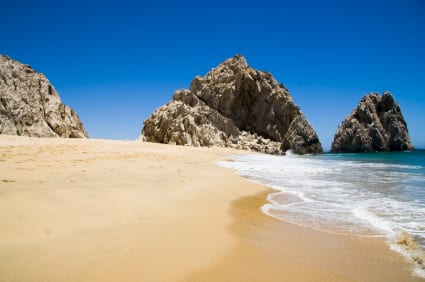Driving south
Yes we did, we loaded our kayaks and packed our cars with camping gear and food, grabbed our passports and headed south to Baja California for spring break. With our two boys and two other families we set off for a week of camping, exploring, bird watching and fishing. We planned to drive two-thirds of the way down the third largest penninsula in the world, to our favorite hidden beach, Playa Escondido, on the Sea of Cortez.
Our first stop south on Baja’s Mexican Highway 1 was about 45 minutes south of the border, the venerable if rustic La Fonda Hotel www.lafondabaja.com. If you only get this far it’s worth the trip. Perched on a bluff overlooking the Pacific Ocean, this famous establishment has inexpensive rooms and a fabulous resturaunt/bar with live music. Margaritas, lobster and dancing to the live band is always a great welcome to Mexico.
Baja Scenery
Innumerable bays and coves break up the coast line of the Pacific Ocean on the west, and the Gulf of Mexico (also known as the Sea of Cortez) on the east. Besides the coastline, perhaps the most outstanding feature of Baja’s Landscape is the chain of rugged mountains that run virtually unbroken down the peninsula. These mountains compose three broad geographical zones, each with a different topography, climates and life form. The change of scenery is extraordinary, from dry desert cactuses unique to Baja, vast expanses of wildflowers, oaises with native Blue Hesper palms. The drive is never boring or tedious, it’s more like a moving picture show.
Guerrero Negro
We arrived in Guerrero Negro just after the sun dropped into the ocean. The landscape here on the Viscaino Plain is flat and barren, and unremarkable; if not for the grey whales there would be little reason to linger. Our favorite simple hotel is Malarrimo, with one of the best restaurants on Baja’s coast.
We woke up early the next morning and drove across evaporative salt ponds to the Ojo de Liebre lagoon, the birthplace of the majority of California grey whales.
At the edge of the tidal flats is the Eco Center, the departure point for organized tours on speedy fiberglass ‘pangas’.
Our three families took up two boats for a high speed ride to the action. Soon mother whales and their calves surrounded our vessel, spouting and ‘spy hopping’ next to our boat. The curious calves come so close we can touch them and look into their mystical dark eyes.
San Ignacio
Our favorite lunch stop is the sleepy town of San Ignacio, situated on a lush oasis of date palms at the foot of a massive extinct volcano.
The first California Missions are dotted along the formidable Baja Penisula. The Jesuit Mission San Ignacio was founded in 1728, more than forty years before San Diego, the first mission in Alta California.
Santa Rosalia
Our first glimpse of the Sea of Cortez was just before Santa Rosalia, a French- built copper mining town of wood buildings with flowers spilling over wrought iron balconies. Near the famous French bakery is a fantastic wrought iron church designed and built by Gustave Eiffel and shipped from France in the early twentieth century.
Mulege
The next destination was Mulege (Moo La Hay), a picturesque village of palm trees set alongside one of the few rivers in Baja. Mulege basks in a setting that is sublime even by Baja California standards.
We ate excellent fish tacos in a small family run restaurant next to the river, and then hit the supermercado for enough ice, milk, beer, meat, and fresh fruit to last a couple of days on the beach.
Bahia Concepcion
After our short stop in Mulege we headed 20 miles south along the Sea of Cortez to our secret spot in Bahia Conception.
With it’s sheltered water, amazing scenery and abundance of marine life, this pristine bay has few equals along the peninsula. The shallow waters along the shoreline and islands offer great snorkeling and kayaking.
The beauty is breathtaking along the winding two lane highway as the Sea of Cortez reveals her calm blue water, rugged dusty mountains in the background.
Unfortunately, when we got to Playa Escondido we discovered that our favorite spot had been ravaged by last year’s hurricane; the beach had dissapeared and the thatched palapas had been destroyed. Dissapointed, we headed south on Highway 1 to look for another spot.
Playa Cocos
Just around the next bend in the road, down a dirt track along a mysterious mangrove lagoon where we found our spot, Playa los Cocos.
Somehow spared the ravages of last year’s hurricane, a thatched palapa stood ready for our arrival and we set up our camp on a beach composed of crushed sea shells.
Most of the other campers were Canadians mixed in with a few gringos from Oregon and Idaho, escaping the frozen north for the beaches of Baja.
The kids explore, swim, kayak, fish, build floating rafts from scrap , and just play. It’s a welcome relief to be away from email, texts, phone calls and computer screens. The children dissapear for hours and come back with treasures of flotsam and shells.
Unlike the Pacific Ocean, there are no swells or waves, but the high tide literally sneaks up to our feet as we sing and tell stories at night around the campfire.
We start the grill and squeeze fresh limes for margaritas just before sunset. My husband happens to make amazing tacos with fresh meat and fish, corn tortillas, and toppings made with fresh everything.
We spend our days searching for shells, snorkeling, fishing, hiking, kayaking, practicing yoga, reading, checking out the dolphins in the bay and learning about the many exotic birds. The birding telescope that our friend Kenny brought was a wonderful addition!
In the morning, a friendly locals arrive selling fresh local shrimp and scallops on ice, delicious hand made tamales, fresh water, and whatever else one needs to subsist on the beach. Every few days Luis, the caretaker of the palapas arrives and collects a small fee for the use of our palapa.
Finally the day came to break camp, pack our vehicles and head home.
El Rosario
We spent our last night in the small town of El Rosario, just to have our last meal at the legendary Mama Espinosa’s Restaurante. Until 1973, this marked the end of the paved road heading south. For more than four decades Dona Anita Grosso de Espinosa has made Mexican dishes for early Baja trekkers. Her family is still at it, serving some of the best food in Baja…we were invited by the daughter to meet Mama herself; she spoke perfect english as she sat and knitted booties of all color and sizes which were sold at her museum; the money goes to the local children in need. She is 104 years old and says her secret to longevity is the local vino rosa!
The Road Home
When we returned home, we were completely revived, enchanted with a country so close, yet so very far away. I recommend looking into the pros and cons of this adventure, but I can assure you, this is one of the most beautiful and unique spots on this planet.
Adios Amigos!
Lorri Kline Ramirez has two boys, and she and her husband are the owners of Ramirez Design Inc., Designers and Builders of custom homes and environments. Ramirez Design has been published in Metropolitan Home Magazine, Elle Décor, Journal de la Maison, and the Los Angeles Times. Their homes have been featured on the television shows “E” entertainment and Style Network. Home tours have been sponsored by LACMA Art & Architecture, CABOOM Design Showcase, Venice Art Walk, and the Children’s Hospital Garden tour. Visit www.ramirezstudio.com





